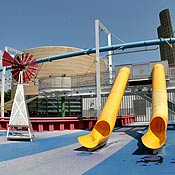Home > Arts & Events >
- PROFILE
- READER REVIEWS
New York Hall of Science
|
|
Official Website
Hours
Sep-Mar: Tue-Thu, 9:30am-2pm; Fri, 9:30am-5pm; Sat-Sun, 10am-6pm; Mon, closed; Apr-Jun: Mon-Thu, 9:30am-2pm; Fri, 9:30am-5pm; Sat-Sun, 10am-6pm; Jul-Aug: Mon-Fri, 9:30am-5pm; Sat-Sun, 10am-6pm
Nearby Subway Stops
7 at 111th St.
Parking
- On Premise Parking
- Street Parking
$10 parking fee
Prices
$11, $8 seniors and children 2-17; free from Sep-Jun on Fri, 2pm-5pm, and Sun, 10am-11am
Payment Methods
American Express, Discover, MasterCard, Visa
Profile
The Great Hall is closed for renovation until 2014.
Great Hall—the oldest part of the New York Hall of Science—was built for the 1964 World's Fair using a special construction technique called dalle de verre. With thousands of glass pieces embedded in 100-foot-high concrete walls, the Great Hall is the largest structure of its kind in the world. While the blue-lit room resembles a temple, the museum's 400-plus interactive exhibits make it feel like a fun-filled playground for children and adults alike. Since 1964, the museum has undergone several major expansions, and its hands-on exhibits have changed to keep up with progress in biology, chemistry, and physics. Giant soap bubbles teach visitors about light, mind-bending optical illusions inform them about perception, and working spectrographs uncover the frequencies in their own voices. Colorful displays in the Hidden Kingdoms area are dedicated to minuscule living things, like the microbes that grow on hands and in refrigerators. The Sports Challenge teaches kids about aerodynamics and balance while they pitch baseballs or surf on a rocking board. And if all that isn't enough to play with, there's an actual Science Playground that lets children climb, slide, and swing their way to more knowledge about everything from motion to solar energy.
North WingOpened in November 2004, the addition more than doubled the museum’s exhibition space and contains exhibits on space, math, art and technology, as well as an area geared toward preschoolers.
Pfizer Foundation Biochemistry Discovery Lab
Visitors can perform real live experiments that take about 10 minutes each, like an experiment that shows how bread gets its holes.
Demonstrations
Demonstrations vary daily, but often include something as interesting—and gross—as the dissection of a cow's eye.
Live Science Theater
Costumed performers act out the physics of bouncing balls or the hair-raising properties of electricity. Shows are geared toward kids and change up to five times a year.
Stellarium
The stars projected onto the ceiling of this small, stuffy planetarium/classroom are a bit fuzzy, so it's recommended only for those who have a keen interest in astronomy.
Tours
Audio tour: docents, who can tell visitors more about exhibits, stand throughout the museum.
Weddings
With more than 400 interactive exhibits, the Hall of Science will entertain even
the most jaded guests. Couples can have their wedding and reception (up to 350
guests) in the colorful, high-ceilinged Viscusi Gallery, and can serve cocktails
for practically as many guests as you can imagine in the exhibition halls. Space
rental starts at $7,000.

